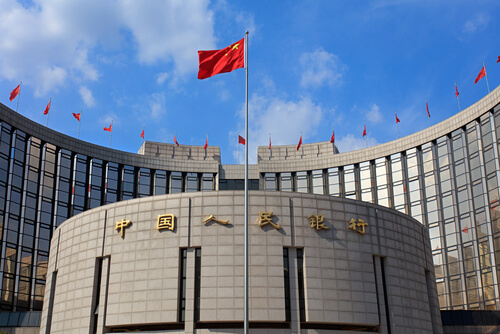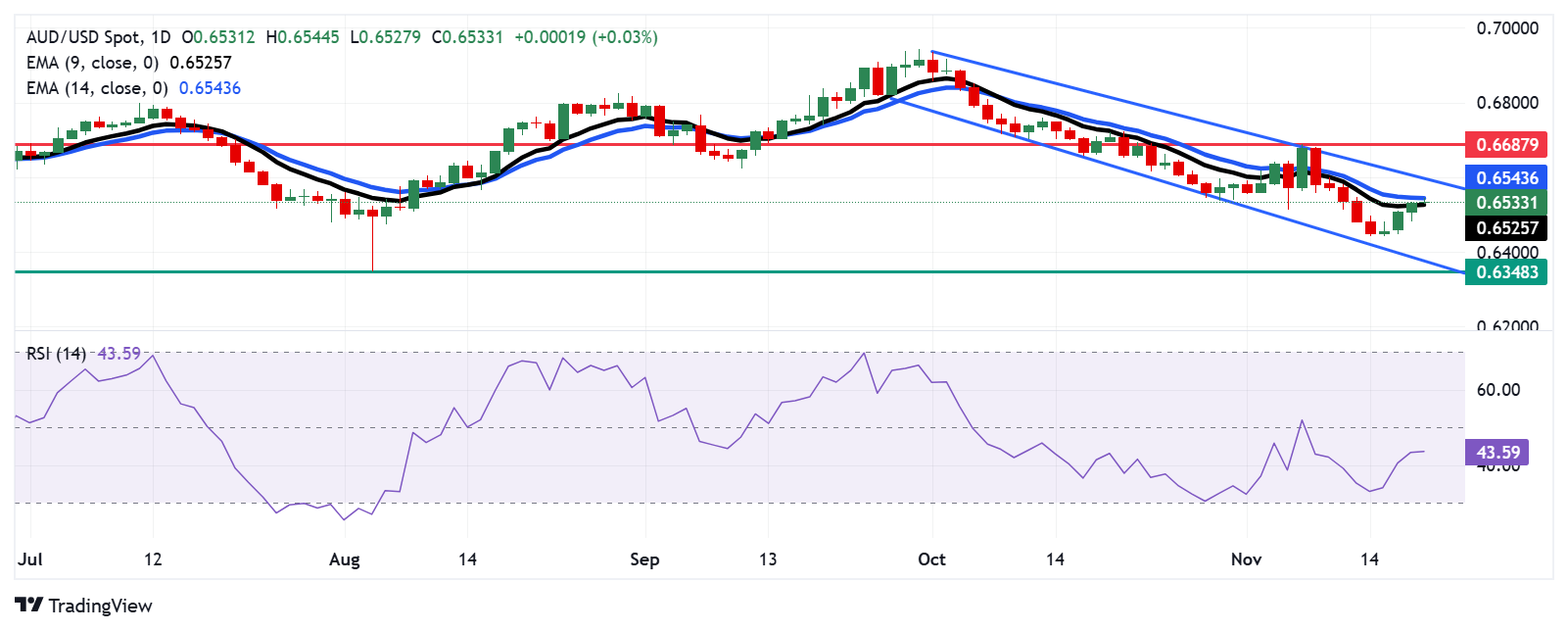Australian Dollar remains steady following PBoC interest rate decision


- The Australian Dollar appreciated as the RBA Meeting Minutes emphasized the importance of maintaining a restrictive monetary policy.
- The PBoC's Monetary Policy Committee (MPC) decided to maintain the current interest rate at 3.1% for November.
- The US Dollar steadies as investors anticipate pro-inflationary policies from the incoming Trump administration.
The Australian Dollar (AUD) attempts to extend its gains for the fourth consecutive day on Wednesday, following the People’s Bank of China’s (PBoC) interest rate decision. The PBoC's Monetary Policy Committee (MPC) opted to keep the benchmark interest rate unchanged at 3.1% for November.
The AUD/USD pair may face downward pressure as the US Dollar (USD) gains ground on safe-haven flows amid escalating tensions in the Russia-Ukraine conflict. According to a Reuters report late Tuesday, Ukraine deployed US-supplied ATACMS missiles to strike Russian territory for the first time, signaling a significant escalation on the 1,000th day of the conflict. However, market concerns eased slightly after Russian Foreign Minister Sergei Lavrov stated that the government would "do everything possible" to prevent the outbreak of nuclear war.
The Reserve Bank of Australia's (RBA) November Meeting Minutes indicated that the central bank’s board remains cautious about the potential for inflation to rise further, emphasizing the need for restrictive monetary policy. Board members also indicate no "immediate need" to adjust the cash rate, though they left the door open for future changes, noting that nothing can be ruled in or out.
The US Dollar (USD) steadies on Wednesday after three consecutive days of losses, pressured by weaker-than-expected economic data released on Tuesday. However, the downside for the Greenback may be capped as investors anticipate pro-inflationary policies from the incoming Trump administration, including tax cuts and higher tariffs. These measures could elevate inflation, possibly influencing the Federal Reserve to slow the pace of rate cuts.
The Australian Dollar receives support from hawkish sentiment surrounding RBA
- Jeffrey Schmid, President of the Federal Reserve Bank of Kansas City, stated on Tuesday that he expects both inflation and employment to move closer to the Fed's targets. Schmid explained that rate cuts signal the Fed's confidence in inflation trending toward its 2% goal. He also noted that while large fiscal deficits won't necessarily drive inflation, the Fed may need to counteract potential pressures with higher interest rates.
- An official from China’s National Development and Reform Commission (NDRC) stated on Tuesday that the country has "ample policy room and tools to support economic recovery." The official expressed confidence in China's economic trajectory, anticipating that the recovery momentum will persist through November and December. Any change in the Chinese economy could impact the Australian markets as both nations are close trade partners.
- Fed Chair Jerome Powell downplayed the likelihood of imminent rate cuts, highlighting the economy's resilience, robust labor market, and persistent inflationary pressures. Powell remarked, "The economy is not sending any signals that we need to be in a hurry to lower rates."
- On Friday, Chicago Fed President Austan Goolsbee stated that markets often overreact to changes in interest rates. Goolsbee emphasized the importance of the Fed adopting a cautious, gradual approach in moving toward the neutral rate.
- Meanwhile, Boston Fed President Susan Collins tempered expectations for continued rate cuts in the near term while maintaining market confidence in a potential rate reduction in December. Collins stated, "I don't see a big urgency to lower rates, but I want to preserve a healthy economy."
- Last week, RBA Governor Michele Bullock emphasized that current interest rates are sufficiently restrictive and will remain unchanged until the central bank is confident about the inflation outlook.
- US Retail Sales increased by 0.4% month-over-month in October, exceeding the market consensus of 0.3%. Additionally, the NY Empire State Manufacturing Index for November posted an unexpected surge, coming in at 31.2 compared to the anticipated 0.7 decline, signaling robust manufacturing activity.
- China’s Retail Sales rose by 4.8% year-over-year in October, surpassing the expected 3.8% and the 3.2% increase seen in September. Meanwhile, Industrial Production grew by 5.3% YoY, below the forecasted 5.6% and the 5.4% growth recorded in the previous period.
Technical Analysis: Australian Dollar surpasses nine-day EMA to approach 0.6550
AUD/USD traded near 0.6530 on Wednesday. Technical analysis of the daily chart indicates a continued decline within a descending channel pattern, underscoring a bearish outlook. The 14-day Relative Strength Index (RSI) is below the 50 mark, further validating the prevailing bearish sentiment.
In terms of support, the AUD/USD pair may approach the lower boundary of the descending channel at the 0.6380 level. A decisive break below the descending channel could amplify selling pressure, potentially driving the pair toward its yearly low of 0.6348, last recorded on August 5.
On the upside, a breach above the nine-day EMA at 0.6525 weakens the bearish bias and supports the AUD/USD pair to test the 14-day EMA at 0.6543 level further. Surpassing this level could pave the way for a rally toward the four-week high of 0.6687 level.
AUD/USD: Daily Chart

Australian Dollar PRICE Today
The table below shows the percentage change of Australian Dollar (AUD) against listed major currencies today. Australian Dollar was the strongest against the Japanese Yen.
| USD | EUR | GBP | JPY | CAD | AUD | NZD | CHF |
|---|---|---|---|---|---|---|---|---|
USD |
| -0.09% | -0.11% | 0.14% | -0.04% | -0.04% | -0.05% | 0.02% |
EUR | 0.09% |
| -0.02% | 0.21% | 0.05% | 0.05% | 0.03% | 0.10% |
GBP | 0.11% | 0.02% |
| 0.24% | 0.07% | 0.07% | 0.05% | 0.13% |
JPY | -0.14% | -0.21% | -0.24% |
| -0.17% | -0.17% | -0.19% | -0.11% |
CAD | 0.04% | -0.05% | -0.07% | 0.17% |
| -0.01% | -0.01% | 0.06% |
AUD | 0.04% | -0.05% | -0.07% | 0.17% | 0.00% |
| -0.01% | 0.07% |
NZD | 0.05% | -0.03% | -0.05% | 0.19% | 0.01% | 0.01% |
| 0.07% |
CHF | -0.02% | -0.10% | -0.13% | 0.11% | -0.06% | -0.07% | -0.07% |
|
The heat map shows percentage changes of major currencies against each other. The base currency is picked from the left column, while the quote currency is picked from the top row. For example, if you pick the Australian Dollar from the left column and move along the horizontal line to the US Dollar, the percentage change displayed in the box will represent AUD (base)/USD (quote).
Economic Indicator
PBoC Interest Rate Decision
The People’s Bank of China’s (PBoC) Monetary Policy Committee (MPC) holds scheduled meetings on a quarterly basis. However, China’s benchmark interest rate – the loan prime rate (LPR), a pricing reference for bank lending – is fixed every month. If the PBoC forecasts high inflation (hawkish) it raises interest rates, which is bullish for the Renminbi (CNY). Likewise, if the PBoC sees inflation in the Chinese economy falling (dovish) and cuts or keeps interest rates unchanged, it is bearish for CNY. Still, China’s currency doesn’t have a floating exchange rate determined by markets and its value against the US Dollar is fixed mainly by the PBoC on a daily basis.
Read more.
Last release: Wed Nov 20, 2024 01:15
Frequency: Irregular
Actual: 3.1%
Consensus: 3.1%
Previous: 3.1%
Source: The People's Bank of China






